HRM Practices in Organizations: A Report on Woodhill, Tesco and ITV
VerifiedAdded on 2023/03/22
|15
|3762
|32
Report
AI Summary
This report provides a comprehensive analysis of Human Resource Management (HRM) practices within three distinct organizations: Woodhill College, Tesco, and ITV. The first section focuses on recruitment and selection at Woodhill College, evaluating the strengths and weaknesses of different approaches. The second section examines employee development, performance, and reward systems at Tesco, including the benefits of HRM practices for both employers and employees and identifying training needs. The third section explores employment relations at ITV, covering the functions and purpose of HRM and the significance of employee relations and key components of employment legislation. The report evaluates the effectiveness of various human resource management activities in increasing productivity and profitability and highlights the importance of HRM in achieving organizational goals.
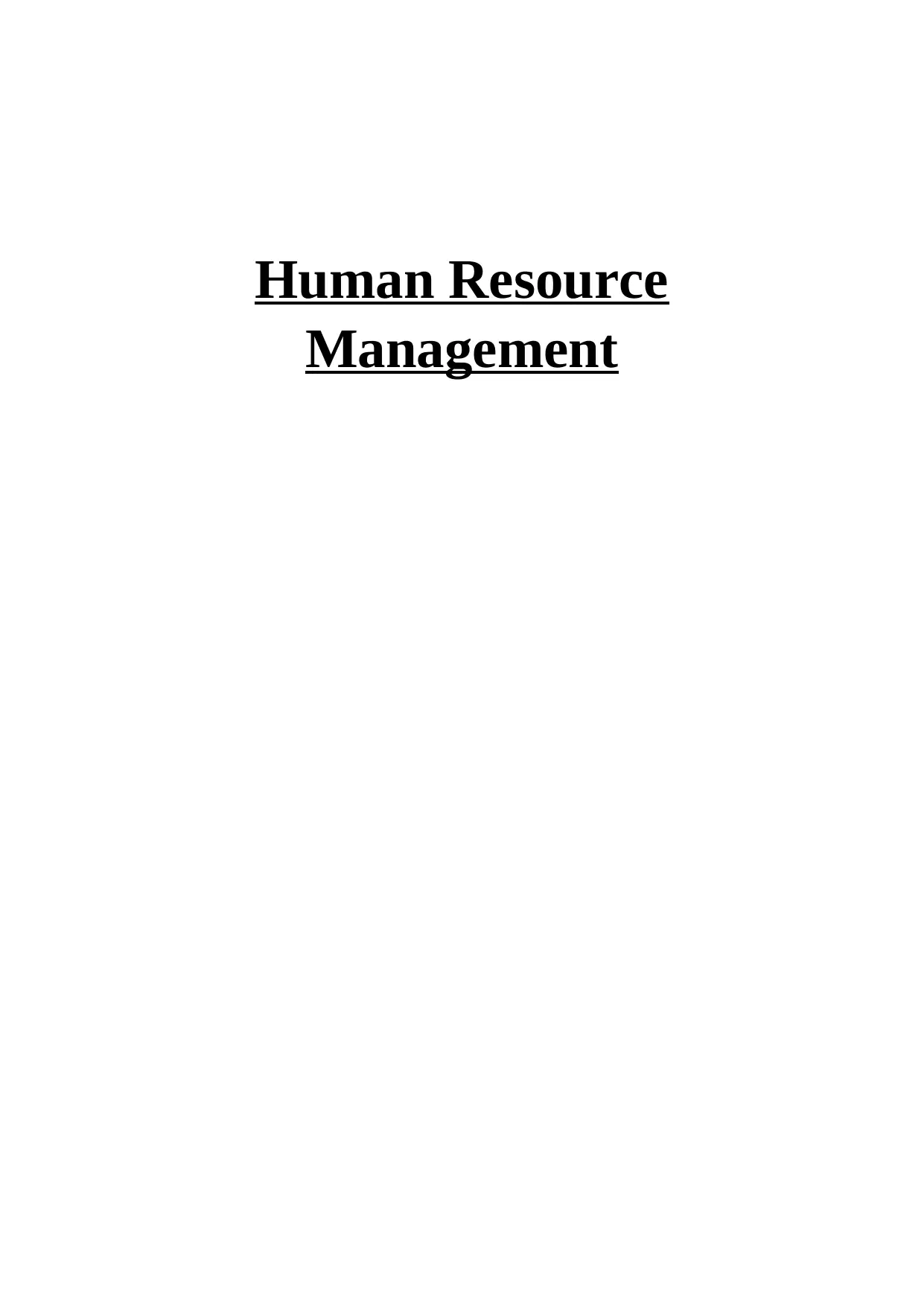
Human Resource
Management
Management
Paraphrase This Document
Need a fresh take? Get an instant paraphrase of this document with our AI Paraphraser
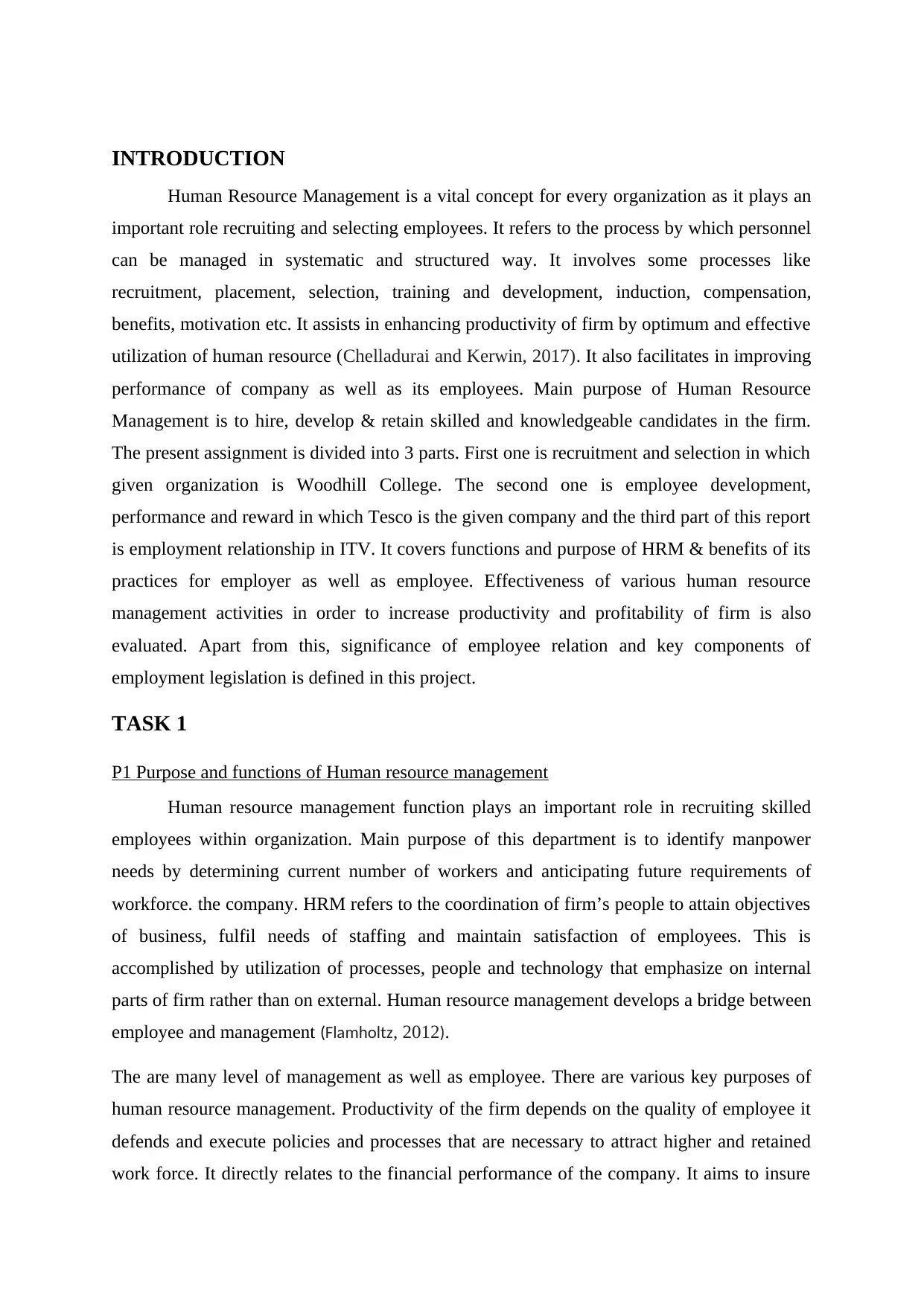
INTRODUCTION
Human Resource Management is a vital concept for every organization as it plays an
important role recruiting and selecting employees. It refers to the process by which personnel
can be managed in systematic and structured way. It involves some processes like
recruitment, placement, selection, training and development, induction, compensation,
benefits, motivation etc. It assists in enhancing productivity of firm by optimum and effective
utilization of human resource (Chelladurai and Kerwin, 2017). It also facilitates in improving
performance of company as well as its employees. Main purpose of Human Resource
Management is to hire, develop & retain skilled and knowledgeable candidates in the firm.
The present assignment is divided into 3 parts. First one is recruitment and selection in which
given organization is Woodhill College. The second one is employee development,
performance and reward in which Tesco is the given company and the third part of this report
is employment relationship in ITV. It covers functions and purpose of HRM & benefits of its
practices for employer as well as employee. Effectiveness of various human resource
management activities in order to increase productivity and profitability of firm is also
evaluated. Apart from this, significance of employee relation and key components of
employment legislation is defined in this project.
TASK 1
P1 Purpose and functions of Human resource management
Human resource management function plays an important role in recruiting skilled
employees within organization. Main purpose of this department is to identify manpower
needs by determining current number of workers and anticipating future requirements of
workforce. the company. HRM refers to the coordination of firm’s people to attain objectives
of business, fulfil needs of staffing and maintain satisfaction of employees. This is
accomplished by utilization of processes, people and technology that emphasize on internal
parts of firm rather than on external. Human resource management develops a bridge between
employee and management (Flamholtz, 2012).
The are many level of management as well as employee. There are various key purposes of
human resource management. Productivity of the firm depends on the quality of employee it
defends and execute policies and processes that are necessary to attract higher and retained
work force. It directly relates to the financial performance of the company. It aims to insure
Human Resource Management is a vital concept for every organization as it plays an
important role recruiting and selecting employees. It refers to the process by which personnel
can be managed in systematic and structured way. It involves some processes like
recruitment, placement, selection, training and development, induction, compensation,
benefits, motivation etc. It assists in enhancing productivity of firm by optimum and effective
utilization of human resource (Chelladurai and Kerwin, 2017). It also facilitates in improving
performance of company as well as its employees. Main purpose of Human Resource
Management is to hire, develop & retain skilled and knowledgeable candidates in the firm.
The present assignment is divided into 3 parts. First one is recruitment and selection in which
given organization is Woodhill College. The second one is employee development,
performance and reward in which Tesco is the given company and the third part of this report
is employment relationship in ITV. It covers functions and purpose of HRM & benefits of its
practices for employer as well as employee. Effectiveness of various human resource
management activities in order to increase productivity and profitability of firm is also
evaluated. Apart from this, significance of employee relation and key components of
employment legislation is defined in this project.
TASK 1
P1 Purpose and functions of Human resource management
Human resource management function plays an important role in recruiting skilled
employees within organization. Main purpose of this department is to identify manpower
needs by determining current number of workers and anticipating future requirements of
workforce. the company. HRM refers to the coordination of firm’s people to attain objectives
of business, fulfil needs of staffing and maintain satisfaction of employees. This is
accomplished by utilization of processes, people and technology that emphasize on internal
parts of firm rather than on external. Human resource management develops a bridge between
employee and management (Flamholtz, 2012).
The are many level of management as well as employee. There are various key purposes of
human resource management. Productivity of the firm depends on the quality of employee it
defends and execute policies and processes that are necessary to attract higher and retained
work force. It directly relates to the financial performance of the company. It aims to insure
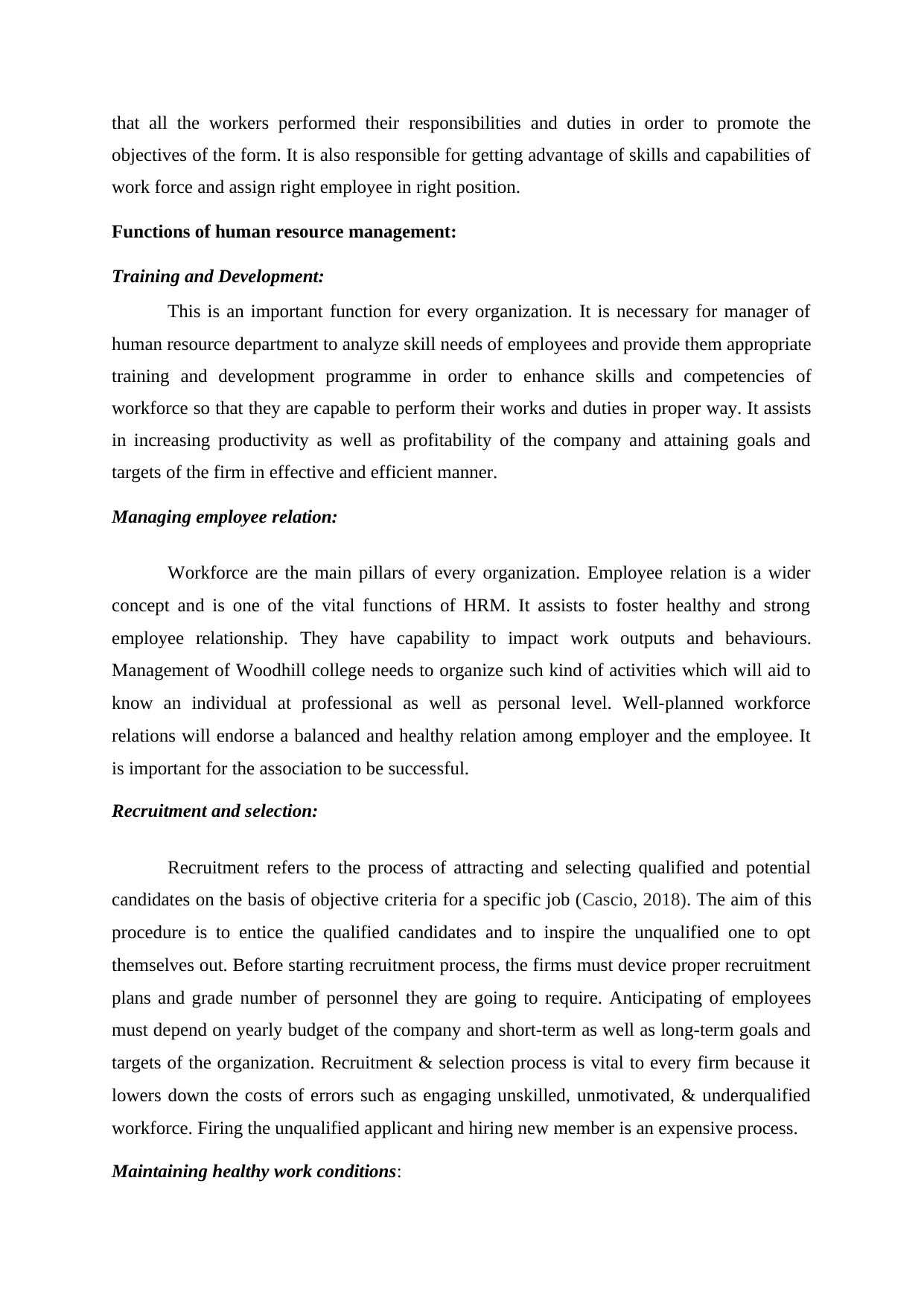
that all the workers performed their responsibilities and duties in order to promote the
objectives of the form. It is also responsible for getting advantage of skills and capabilities of
work force and assign right employee in right position.
Functions of human resource management:
Training and Development:
This is an important function for every organization. It is necessary for manager of
human resource department to analyze skill needs of employees and provide them appropriate
training and development programme in order to enhance skills and competencies of
workforce so that they are capable to perform their works and duties in proper way. It assists
in increasing productivity as well as profitability of the company and attaining goals and
targets of the firm in effective and efficient manner.
Managing employee relation:
Workforce are the main pillars of every organization. Employee relation is a wider
concept and is one of the vital functions of HRM. It assists to foster healthy and strong
employee relationship. They have capability to impact work outputs and behaviours.
Management of Woodhill college needs to organize such kind of activities which will aid to
know an individual at professional as well as personal level. Well-planned workforce
relations will endorse a balanced and healthy relation among employer and the employee. It
is important for the association to be successful.
Recruitment and selection:
Recruitment refers to the process of attracting and selecting qualified and potential
candidates on the basis of objective criteria for a specific job (Cascio, 2018). The aim of this
procedure is to entice the qualified candidates and to inspire the unqualified one to opt
themselves out. Before starting recruitment process, the firms must device proper recruitment
plans and grade number of personnel they are going to require. Anticipating of employees
must depend on yearly budget of the company and short-term as well as long-term goals and
targets of the organization. Recruitment & selection process is vital to every firm because it
lowers down the costs of errors such as engaging unskilled, unmotivated, & underqualified
workforce. Firing the unqualified applicant and hiring new member is an expensive process.
Maintaining healthy work conditions:
objectives of the form. It is also responsible for getting advantage of skills and capabilities of
work force and assign right employee in right position.
Functions of human resource management:
Training and Development:
This is an important function for every organization. It is necessary for manager of
human resource department to analyze skill needs of employees and provide them appropriate
training and development programme in order to enhance skills and competencies of
workforce so that they are capable to perform their works and duties in proper way. It assists
in increasing productivity as well as profitability of the company and attaining goals and
targets of the firm in effective and efficient manner.
Managing employee relation:
Workforce are the main pillars of every organization. Employee relation is a wider
concept and is one of the vital functions of HRM. It assists to foster healthy and strong
employee relationship. They have capability to impact work outputs and behaviours.
Management of Woodhill college needs to organize such kind of activities which will aid to
know an individual at professional as well as personal level. Well-planned workforce
relations will endorse a balanced and healthy relation among employer and the employee. It
is important for the association to be successful.
Recruitment and selection:
Recruitment refers to the process of attracting and selecting qualified and potential
candidates on the basis of objective criteria for a specific job (Cascio, 2018). The aim of this
procedure is to entice the qualified candidates and to inspire the unqualified one to opt
themselves out. Before starting recruitment process, the firms must device proper recruitment
plans and grade number of personnel they are going to require. Anticipating of employees
must depend on yearly budget of the company and short-term as well as long-term goals and
targets of the organization. Recruitment & selection process is vital to every firm because it
lowers down the costs of errors such as engaging unskilled, unmotivated, & underqualified
workforce. Firing the unqualified applicant and hiring new member is an expensive process.
Maintaining healthy work conditions:
⊘ This is a preview!⊘
Do you want full access?
Subscribe today to unlock all pages.

Trusted by 1+ million students worldwide
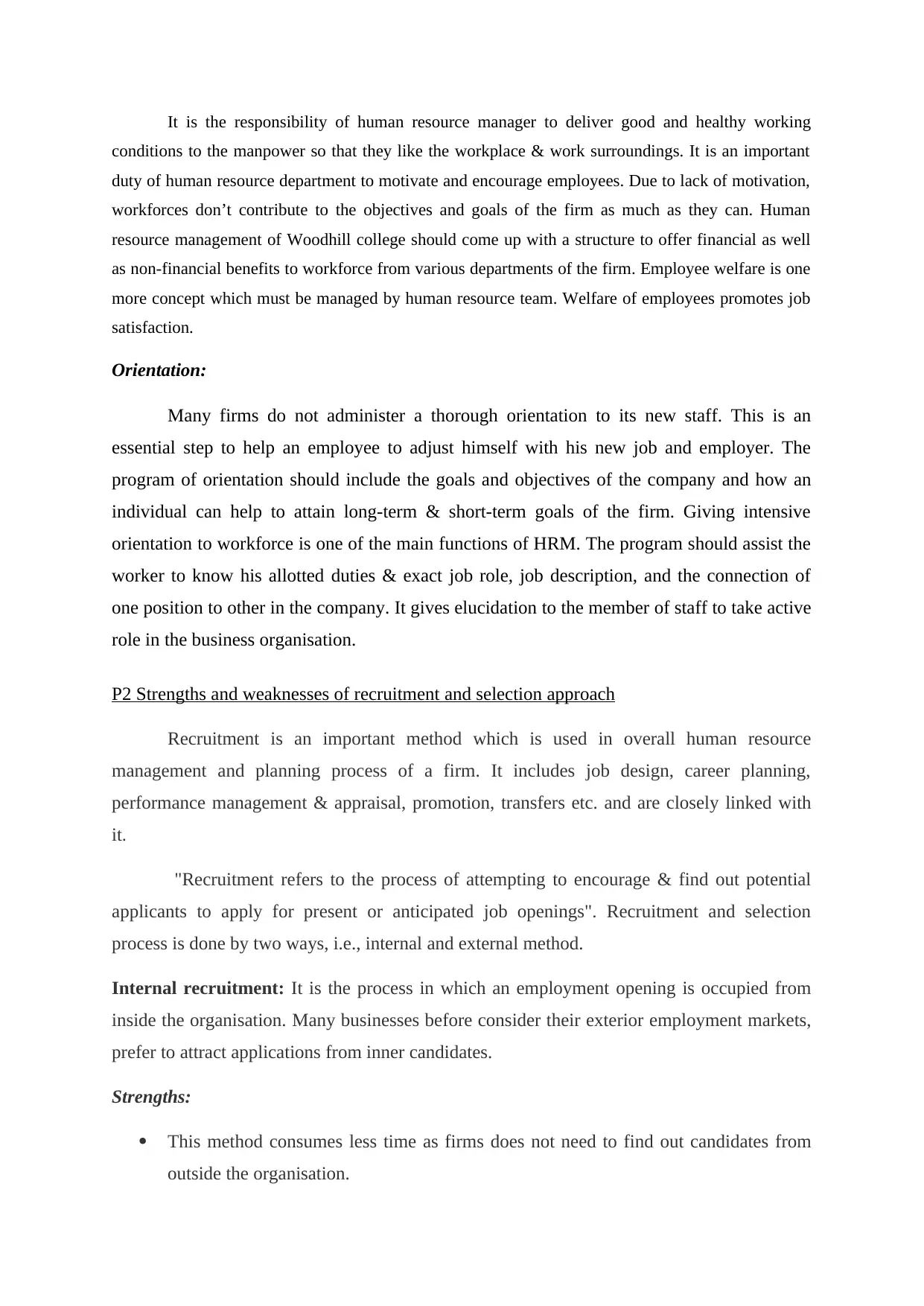
It is the responsibility of human resource manager to deliver good and healthy working
conditions to the manpower so that they like the workplace & work surroundings. It is an important
duty of human resource department to motivate and encourage employees. Due to lack of motivation,
workforces don’t contribute to the objectives and goals of the firm as much as they can. Human
resource management of Woodhill college should come up with a structure to offer financial as well
as non-financial benefits to workforce from various departments of the firm. Employee welfare is one
more concept which must be managed by human resource team. Welfare of employees promotes job
satisfaction.
Orientation:
Many firms do not administer a thorough orientation to its new staff. This is an
essential step to help an employee to adjust himself with his new job and employer. The
program of orientation should include the goals and objectives of the company and how an
individual can help to attain long-term & short-term goals of the firm. Giving intensive
orientation to workforce is one of the main functions of HRM. The program should assist the
worker to know his allotted duties & exact job role, job description, and the connection of
one position to other in the company. It gives elucidation to the member of staff to take active
role in the business organisation.
P2 Strengths and weaknesses of recruitment and selection approach
Recruitment is an important method which is used in overall human resource
management and planning process of a firm. It includes job design, career planning,
performance management & appraisal, promotion, transfers etc. and are closely linked with
it.
"Recruitment refers to the process of attempting to encourage & find out potential
applicants to apply for present or anticipated job openings". Recruitment and selection
process is done by two ways, i.e., internal and external method.
Internal recruitment: It is the process in which an employment opening is occupied from
inside the organisation. Many businesses before consider their exterior employment markets,
prefer to attract applications from inner candidates.
Strengths:
This method consumes less time as firms does not need to find out candidates from
outside the organisation.
conditions to the manpower so that they like the workplace & work surroundings. It is an important
duty of human resource department to motivate and encourage employees. Due to lack of motivation,
workforces don’t contribute to the objectives and goals of the firm as much as they can. Human
resource management of Woodhill college should come up with a structure to offer financial as well
as non-financial benefits to workforce from various departments of the firm. Employee welfare is one
more concept which must be managed by human resource team. Welfare of employees promotes job
satisfaction.
Orientation:
Many firms do not administer a thorough orientation to its new staff. This is an
essential step to help an employee to adjust himself with his new job and employer. The
program of orientation should include the goals and objectives of the company and how an
individual can help to attain long-term & short-term goals of the firm. Giving intensive
orientation to workforce is one of the main functions of HRM. The program should assist the
worker to know his allotted duties & exact job role, job description, and the connection of
one position to other in the company. It gives elucidation to the member of staff to take active
role in the business organisation.
P2 Strengths and weaknesses of recruitment and selection approach
Recruitment is an important method which is used in overall human resource
management and planning process of a firm. It includes job design, career planning,
performance management & appraisal, promotion, transfers etc. and are closely linked with
it.
"Recruitment refers to the process of attempting to encourage & find out potential
applicants to apply for present or anticipated job openings". Recruitment and selection
process is done by two ways, i.e., internal and external method.
Internal recruitment: It is the process in which an employment opening is occupied from
inside the organisation. Many businesses before consider their exterior employment markets,
prefer to attract applications from inner candidates.
Strengths:
This method consumes less time as firms does not need to find out candidates from
outside the organisation.
Paraphrase This Document
Need a fresh take? Get an instant paraphrase of this document with our AI Paraphraser
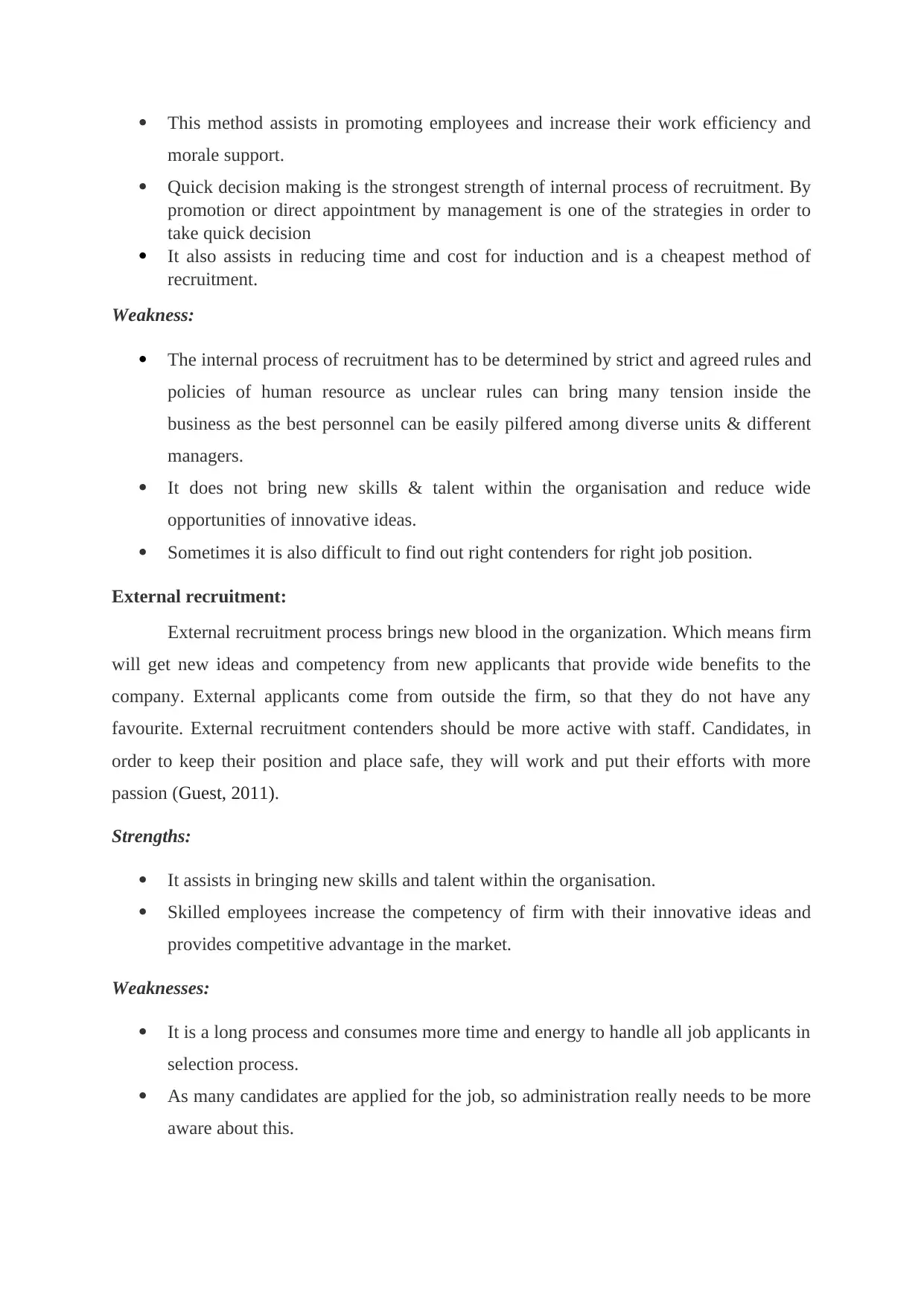
This method assists in promoting employees and increase their work efficiency and
morale support.
Quick decision making is the strongest strength of internal process of recruitment. By
promotion or direct appointment by management is one of the strategies in order to
take quick decision
It also assists in reducing time and cost for induction and is a cheapest method of
recruitment.
Weakness:
The internal process of recruitment has to be determined by strict and agreed rules and
policies of human resource as unclear rules can bring many tension inside the
business as the best personnel can be easily pilfered among diverse units & different
managers.
It does not bring new skills & talent within the organisation and reduce wide
opportunities of innovative ideas.
Sometimes it is also difficult to find out right contenders for right job position.
External recruitment:
External recruitment process brings new blood in the organization. Which means firm
will get new ideas and competency from new applicants that provide wide benefits to the
company. External applicants come from outside the firm, so that they do not have any
favourite. External recruitment contenders should be more active with staff. Candidates, in
order to keep their position and place safe, they will work and put their efforts with more
passion (Guest, 2011).
Strengths:
It assists in bringing new skills and talent within the organisation.
Skilled employees increase the competency of firm with their innovative ideas and
provides competitive advantage in the market.
Weaknesses:
It is a long process and consumes more time and energy to handle all job applicants in
selection process.
As many candidates are applied for the job, so administration really needs to be more
aware about this.
morale support.
Quick decision making is the strongest strength of internal process of recruitment. By
promotion or direct appointment by management is one of the strategies in order to
take quick decision
It also assists in reducing time and cost for induction and is a cheapest method of
recruitment.
Weakness:
The internal process of recruitment has to be determined by strict and agreed rules and
policies of human resource as unclear rules can bring many tension inside the
business as the best personnel can be easily pilfered among diverse units & different
managers.
It does not bring new skills & talent within the organisation and reduce wide
opportunities of innovative ideas.
Sometimes it is also difficult to find out right contenders for right job position.
External recruitment:
External recruitment process brings new blood in the organization. Which means firm
will get new ideas and competency from new applicants that provide wide benefits to the
company. External applicants come from outside the firm, so that they do not have any
favourite. External recruitment contenders should be more active with staff. Candidates, in
order to keep their position and place safe, they will work and put their efforts with more
passion (Guest, 2011).
Strengths:
It assists in bringing new skills and talent within the organisation.
Skilled employees increase the competency of firm with their innovative ideas and
provides competitive advantage in the market.
Weaknesses:
It is a long process and consumes more time and energy to handle all job applicants in
selection process.
As many candidates are applied for the job, so administration really needs to be more
aware about this.
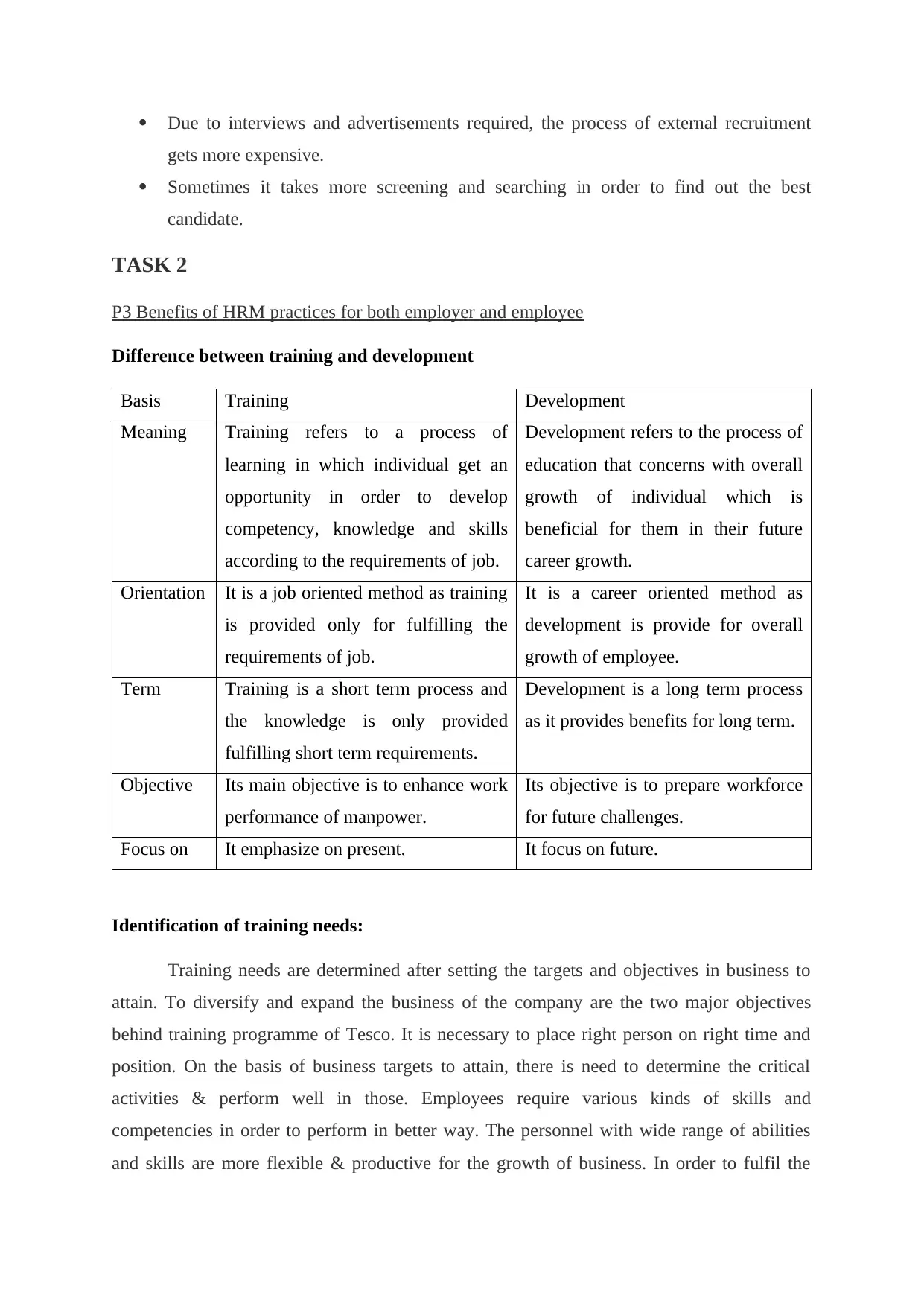
Due to interviews and advertisements required, the process of external recruitment
gets more expensive.
Sometimes it takes more screening and searching in order to find out the best
candidate.
TASK 2
P3 Benefits of HRM practices for both employer and employee
Difference between training and development
Basis Training Development
Meaning Training refers to a process of
learning in which individual get an
opportunity in order to develop
competency, knowledge and skills
according to the requirements of job.
Development refers to the process of
education that concerns with overall
growth of individual which is
beneficial for them in their future
career growth.
Orientation It is a job oriented method as training
is provided only for fulfilling the
requirements of job.
It is a career oriented method as
development is provide for overall
growth of employee.
Term Training is a short term process and
the knowledge is only provided
fulfilling short term requirements.
Development is a long term process
as it provides benefits for long term.
Objective Its main objective is to enhance work
performance of manpower.
Its objective is to prepare workforce
for future challenges.
Focus on It emphasize on present. It focus on future.
Identification of training needs:
Training needs are determined after setting the targets and objectives in business to
attain. To diversify and expand the business of the company are the two major objectives
behind training programme of Tesco. It is necessary to place right person on right time and
position. On the basis of business targets to attain, there is need to determine the critical
activities & perform well in those. Employees require various kinds of skills and
competencies in order to perform in better way. The personnel with wide range of abilities
and skills are more flexible & productive for the growth of business. In order to fulfil the
gets more expensive.
Sometimes it takes more screening and searching in order to find out the best
candidate.
TASK 2
P3 Benefits of HRM practices for both employer and employee
Difference between training and development
Basis Training Development
Meaning Training refers to a process of
learning in which individual get an
opportunity in order to develop
competency, knowledge and skills
according to the requirements of job.
Development refers to the process of
education that concerns with overall
growth of individual which is
beneficial for them in their future
career growth.
Orientation It is a job oriented method as training
is provided only for fulfilling the
requirements of job.
It is a career oriented method as
development is provide for overall
growth of employee.
Term Training is a short term process and
the knowledge is only provided
fulfilling short term requirements.
Development is a long term process
as it provides benefits for long term.
Objective Its main objective is to enhance work
performance of manpower.
Its objective is to prepare workforce
for future challenges.
Focus on It emphasize on present. It focus on future.
Identification of training needs:
Training needs are determined after setting the targets and objectives in business to
attain. To diversify and expand the business of the company are the two major objectives
behind training programme of Tesco. It is necessary to place right person on right time and
position. On the basis of business targets to attain, there is need to determine the critical
activities & perform well in those. Employees require various kinds of skills and
competencies in order to perform in better way. The personnel with wide range of abilities
and skills are more flexible & productive for the growth of business. In order to fulfil the
⊘ This is a preview!⊘
Do you want full access?
Subscribe today to unlock all pages.

Trusted by 1+ million students worldwide
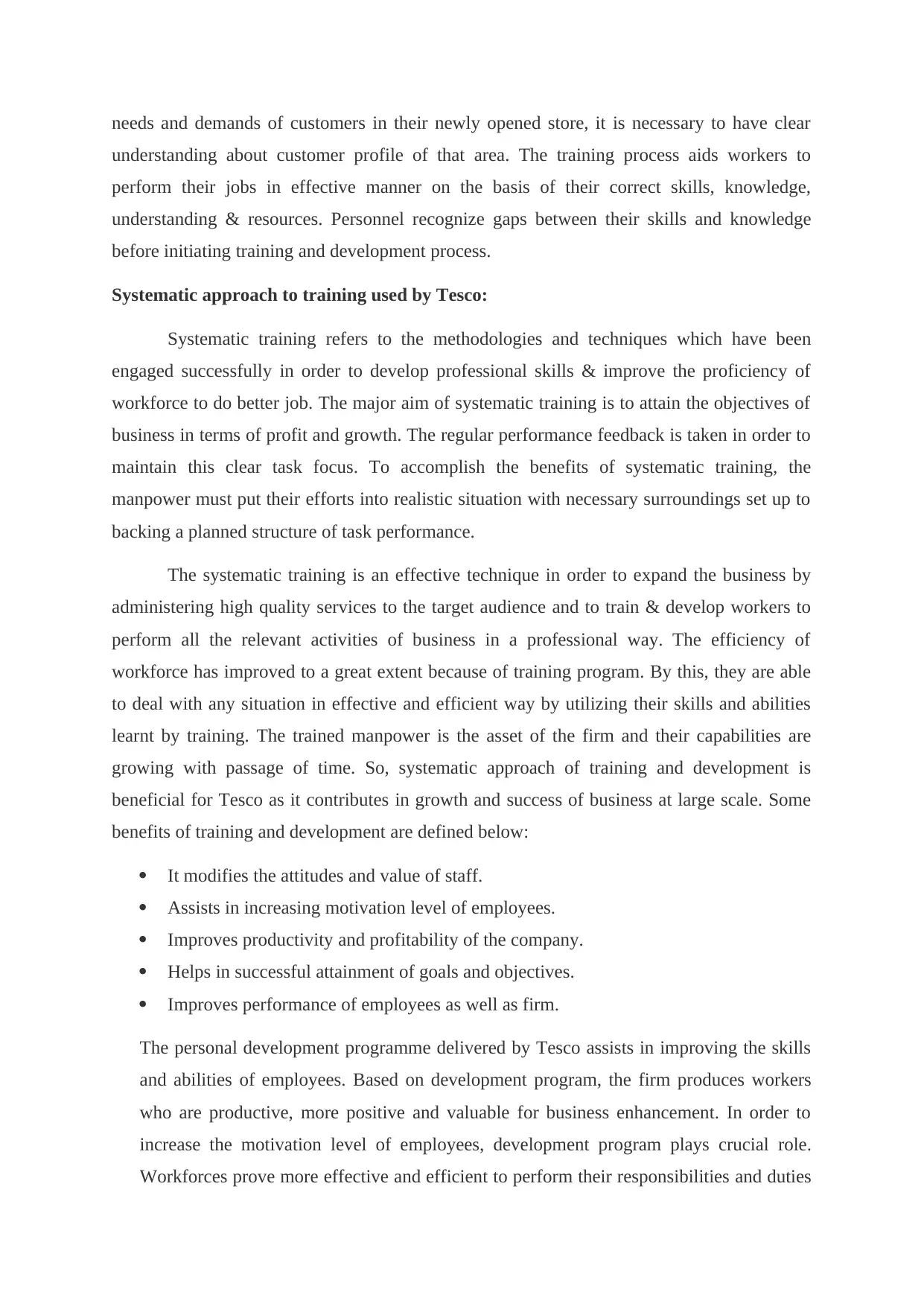
needs and demands of customers in their newly opened store, it is necessary to have clear
understanding about customer profile of that area. The training process aids workers to
perform their jobs in effective manner on the basis of their correct skills, knowledge,
understanding & resources. Personnel recognize gaps between their skills and knowledge
before initiating training and development process.
Systematic approach to training used by Tesco:
Systematic training refers to the methodologies and techniques which have been
engaged successfully in order to develop professional skills & improve the proficiency of
workforce to do better job. The major aim of systematic training is to attain the objectives of
business in terms of profit and growth. The regular performance feedback is taken in order to
maintain this clear task focus. To accomplish the benefits of systematic training, the
manpower must put their efforts into realistic situation with necessary surroundings set up to
backing a planned structure of task performance.
The systematic training is an effective technique in order to expand the business by
administering high quality services to the target audience and to train & develop workers to
perform all the relevant activities of business in a professional way. The efficiency of
workforce has improved to a great extent because of training program. By this, they are able
to deal with any situation in effective and efficient way by utilizing their skills and abilities
learnt by training. The trained manpower is the asset of the firm and their capabilities are
growing with passage of time. So, systematic approach of training and development is
beneficial for Tesco as it contributes in growth and success of business at large scale. Some
benefits of training and development are defined below:
It modifies the attitudes and value of staff.
Assists in increasing motivation level of employees.
Improves productivity and profitability of the company.
Helps in successful attainment of goals and objectives.
Improves performance of employees as well as firm.
The personal development programme delivered by Tesco assists in improving the skills
and abilities of employees. Based on development program, the firm produces workers
who are productive, more positive and valuable for business enhancement. In order to
increase the motivation level of employees, development program plays crucial role.
Workforces prove more effective and efficient to perform their responsibilities and duties
understanding about customer profile of that area. The training process aids workers to
perform their jobs in effective manner on the basis of their correct skills, knowledge,
understanding & resources. Personnel recognize gaps between their skills and knowledge
before initiating training and development process.
Systematic approach to training used by Tesco:
Systematic training refers to the methodologies and techniques which have been
engaged successfully in order to develop professional skills & improve the proficiency of
workforce to do better job. The major aim of systematic training is to attain the objectives of
business in terms of profit and growth. The regular performance feedback is taken in order to
maintain this clear task focus. To accomplish the benefits of systematic training, the
manpower must put their efforts into realistic situation with necessary surroundings set up to
backing a planned structure of task performance.
The systematic training is an effective technique in order to expand the business by
administering high quality services to the target audience and to train & develop workers to
perform all the relevant activities of business in a professional way. The efficiency of
workforce has improved to a great extent because of training program. By this, they are able
to deal with any situation in effective and efficient way by utilizing their skills and abilities
learnt by training. The trained manpower is the asset of the firm and their capabilities are
growing with passage of time. So, systematic approach of training and development is
beneficial for Tesco as it contributes in growth and success of business at large scale. Some
benefits of training and development are defined below:
It modifies the attitudes and value of staff.
Assists in increasing motivation level of employees.
Improves productivity and profitability of the company.
Helps in successful attainment of goals and objectives.
Improves performance of employees as well as firm.
The personal development programme delivered by Tesco assists in improving the skills
and abilities of employees. Based on development program, the firm produces workers
who are productive, more positive and valuable for business enhancement. In order to
increase the motivation level of employees, development program plays crucial role.
Workforces prove more effective and efficient to perform their responsibilities and duties
Paraphrase This Document
Need a fresh take? Get an instant paraphrase of this document with our AI Paraphraser
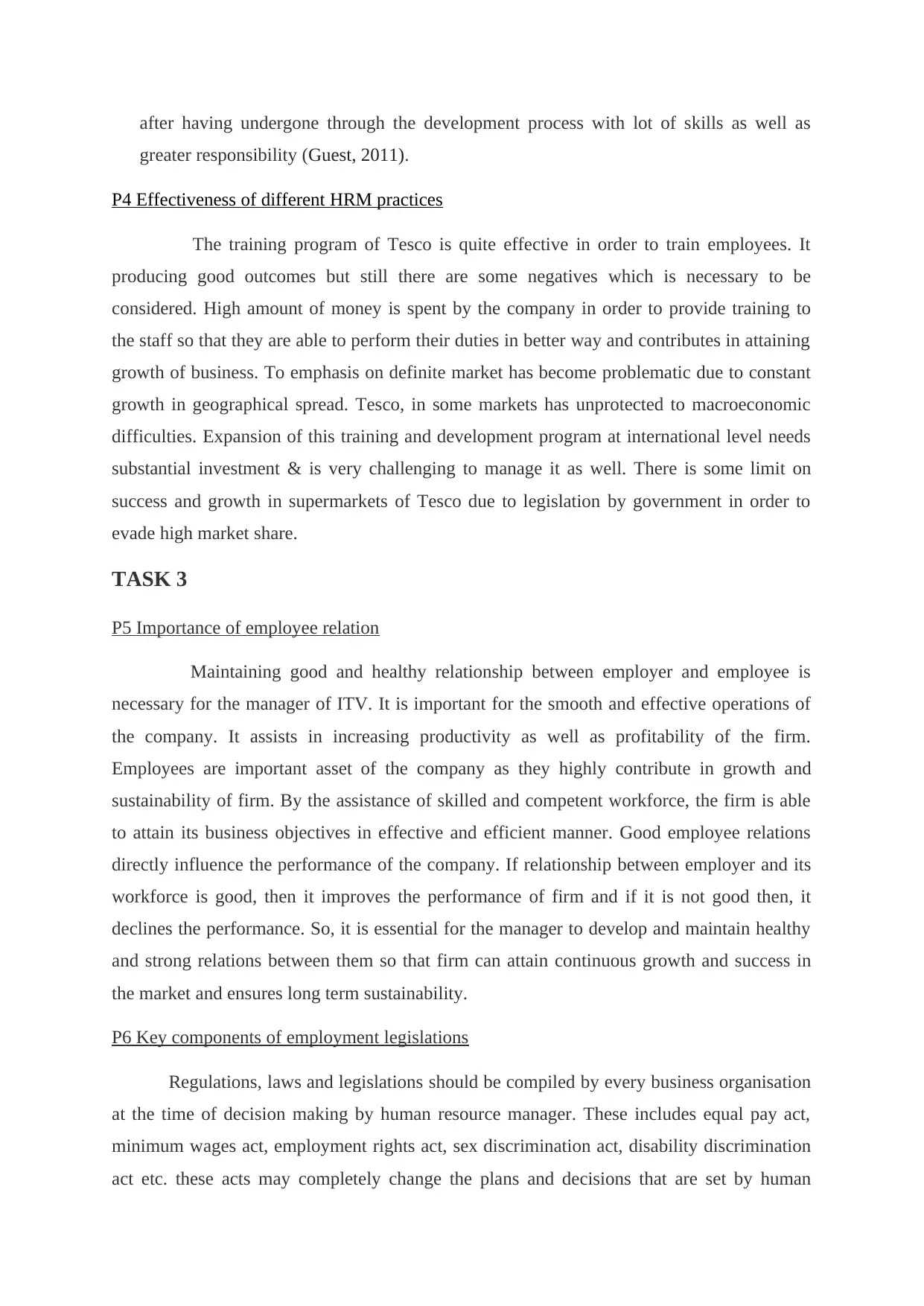
after having undergone through the development process with lot of skills as well as
greater responsibility (Guest, 2011).
P4 Effectiveness of different HRM practices
The training program of Tesco is quite effective in order to train employees. It
producing good outcomes but still there are some negatives which is necessary to be
considered. High amount of money is spent by the company in order to provide training to
the staff so that they are able to perform their duties in better way and contributes in attaining
growth of business. To emphasis on definite market has become problematic due to constant
growth in geographical spread. Tesco, in some markets has unprotected to macroeconomic
difficulties. Expansion of this training and development program at international level needs
substantial investment & is very challenging to manage it as well. There is some limit on
success and growth in supermarkets of Tesco due to legislation by government in order to
evade high market share.
TASK 3
P5 Importance of employee relation
Maintaining good and healthy relationship between employer and employee is
necessary for the manager of ITV. It is important for the smooth and effective operations of
the company. It assists in increasing productivity as well as profitability of the firm.
Employees are important asset of the company as they highly contribute in growth and
sustainability of firm. By the assistance of skilled and competent workforce, the firm is able
to attain its business objectives in effective and efficient manner. Good employee relations
directly influence the performance of the company. If relationship between employer and its
workforce is good, then it improves the performance of firm and if it is not good then, it
declines the performance. So, it is essential for the manager to develop and maintain healthy
and strong relations between them so that firm can attain continuous growth and success in
the market and ensures long term sustainability.
P6 Key components of employment legislations
Regulations, laws and legislations should be compiled by every business organisation
at the time of decision making by human resource manager. These includes equal pay act,
minimum wages act, employment rights act, sex discrimination act, disability discrimination
act etc. these acts may completely change the plans and decisions that are set by human
greater responsibility (Guest, 2011).
P4 Effectiveness of different HRM practices
The training program of Tesco is quite effective in order to train employees. It
producing good outcomes but still there are some negatives which is necessary to be
considered. High amount of money is spent by the company in order to provide training to
the staff so that they are able to perform their duties in better way and contributes in attaining
growth of business. To emphasis on definite market has become problematic due to constant
growth in geographical spread. Tesco, in some markets has unprotected to macroeconomic
difficulties. Expansion of this training and development program at international level needs
substantial investment & is very challenging to manage it as well. There is some limit on
success and growth in supermarkets of Tesco due to legislation by government in order to
evade high market share.
TASK 3
P5 Importance of employee relation
Maintaining good and healthy relationship between employer and employee is
necessary for the manager of ITV. It is important for the smooth and effective operations of
the company. It assists in increasing productivity as well as profitability of the firm.
Employees are important asset of the company as they highly contribute in growth and
sustainability of firm. By the assistance of skilled and competent workforce, the firm is able
to attain its business objectives in effective and efficient manner. Good employee relations
directly influence the performance of the company. If relationship between employer and its
workforce is good, then it improves the performance of firm and if it is not good then, it
declines the performance. So, it is essential for the manager to develop and maintain healthy
and strong relations between them so that firm can attain continuous growth and success in
the market and ensures long term sustainability.
P6 Key components of employment legislations
Regulations, laws and legislations should be compiled by every business organisation
at the time of decision making by human resource manager. These includes equal pay act,
minimum wages act, employment rights act, sex discrimination act, disability discrimination
act etc. these acts may completely change the plans and decisions that are set by human
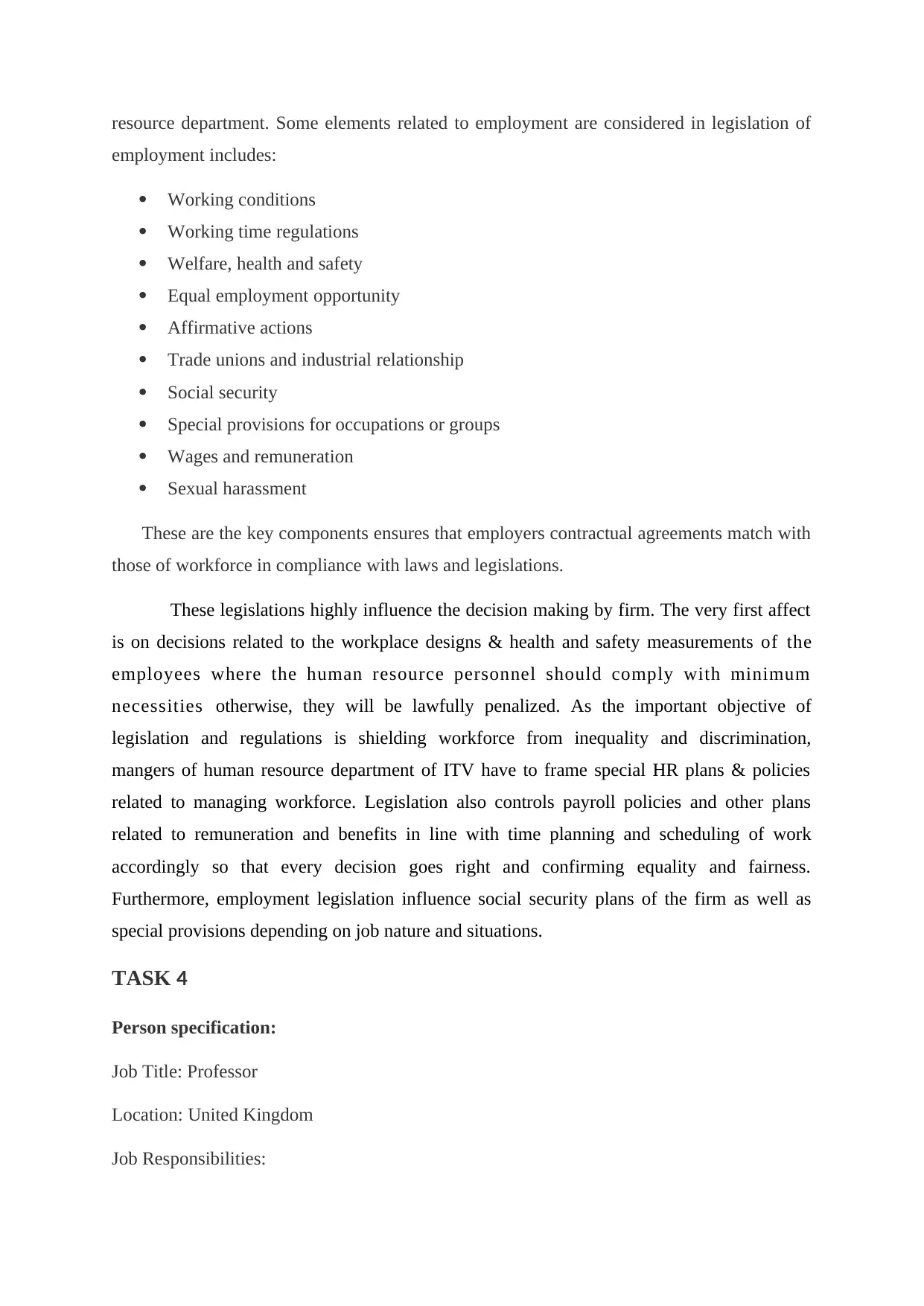
resource department. Some elements related to employment are considered in legislation of
employment includes:
Working conditions
Working time regulations
Welfare, health and safety
Equal employment opportunity
Affirmative actions
Trade unions and industrial relationship
Social security
Special provisions for occupations or groups
Wages and remuneration
Sexual harassment
These are the key components ensures that employers contractual agreements match with
those of workforce in compliance with laws and legislations.
These legislations highly influence the decision making by firm. The very first affect
is on decisions related to the workplace designs & health and safety measurements of the
employees where the human resource personnel should comply with minimum
necessities otherwise, they will be lawfully penalized. As the important objective of
legislation and regulations is shielding workforce from inequality and discrimination,
mangers of human resource department of ITV have to frame special HR plans & policies
related to managing workforce. Legislation also controls payroll policies and other plans
related to remuneration and benefits in line with time planning and scheduling of work
accordingly so that every decision goes right and confirming equality and fairness.
Furthermore, employment legislation influence social security plans of the firm as well as
special provisions depending on job nature and situations.
TASK 4
Person specification:
Job Title: Professor
Location: United Kingdom
Job Responsibilities:
employment includes:
Working conditions
Working time regulations
Welfare, health and safety
Equal employment opportunity
Affirmative actions
Trade unions and industrial relationship
Social security
Special provisions for occupations or groups
Wages and remuneration
Sexual harassment
These are the key components ensures that employers contractual agreements match with
those of workforce in compliance with laws and legislations.
These legislations highly influence the decision making by firm. The very first affect
is on decisions related to the workplace designs & health and safety measurements of the
employees where the human resource personnel should comply with minimum
necessities otherwise, they will be lawfully penalized. As the important objective of
legislation and regulations is shielding workforce from inequality and discrimination,
mangers of human resource department of ITV have to frame special HR plans & policies
related to managing workforce. Legislation also controls payroll policies and other plans
related to remuneration and benefits in line with time planning and scheduling of work
accordingly so that every decision goes right and confirming equality and fairness.
Furthermore, employment legislation influence social security plans of the firm as well as
special provisions depending on job nature and situations.
TASK 4
Person specification:
Job Title: Professor
Location: United Kingdom
Job Responsibilities:
⊘ This is a preview!⊘
Do you want full access?
Subscribe today to unlock all pages.

Trusted by 1+ million students worldwide
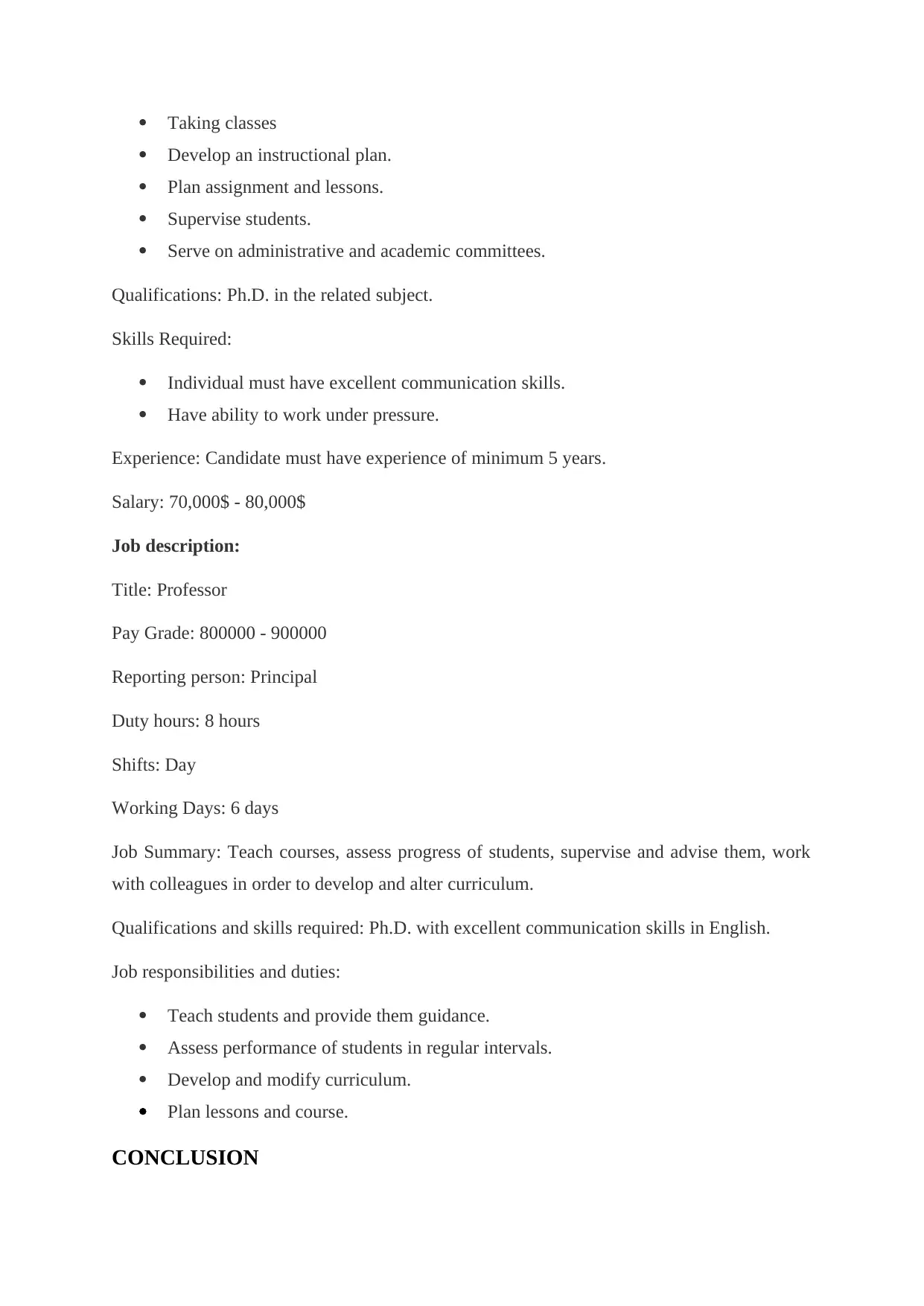
Taking classes
Develop an instructional plan.
Plan assignment and lessons.
Supervise students.
Serve on administrative and academic committees.
Qualifications: Ph.D. in the related subject.
Skills Required:
Individual must have excellent communication skills.
Have ability to work under pressure.
Experience: Candidate must have experience of minimum 5 years.
Salary: 70,000$ - 80,000$
Job description:
Title: Professor
Pay Grade: 800000 - 900000
Reporting person: Principal
Duty hours: 8 hours
Shifts: Day
Working Days: 6 days
Job Summary: Teach courses, assess progress of students, supervise and advise them, work
with colleagues in order to develop and alter curriculum.
Qualifications and skills required: Ph.D. with excellent communication skills in English.
Job responsibilities and duties:
Teach students and provide them guidance.
Assess performance of students in regular intervals.
Develop and modify curriculum.
Plan lessons and course.
CONCLUSION
Develop an instructional plan.
Plan assignment and lessons.
Supervise students.
Serve on administrative and academic committees.
Qualifications: Ph.D. in the related subject.
Skills Required:
Individual must have excellent communication skills.
Have ability to work under pressure.
Experience: Candidate must have experience of minimum 5 years.
Salary: 70,000$ - 80,000$
Job description:
Title: Professor
Pay Grade: 800000 - 900000
Reporting person: Principal
Duty hours: 8 hours
Shifts: Day
Working Days: 6 days
Job Summary: Teach courses, assess progress of students, supervise and advise them, work
with colleagues in order to develop and alter curriculum.
Qualifications and skills required: Ph.D. with excellent communication skills in English.
Job responsibilities and duties:
Teach students and provide them guidance.
Assess performance of students in regular intervals.
Develop and modify curriculum.
Plan lessons and course.
CONCLUSION
Paraphrase This Document
Need a fresh take? Get an instant paraphrase of this document with our AI Paraphraser
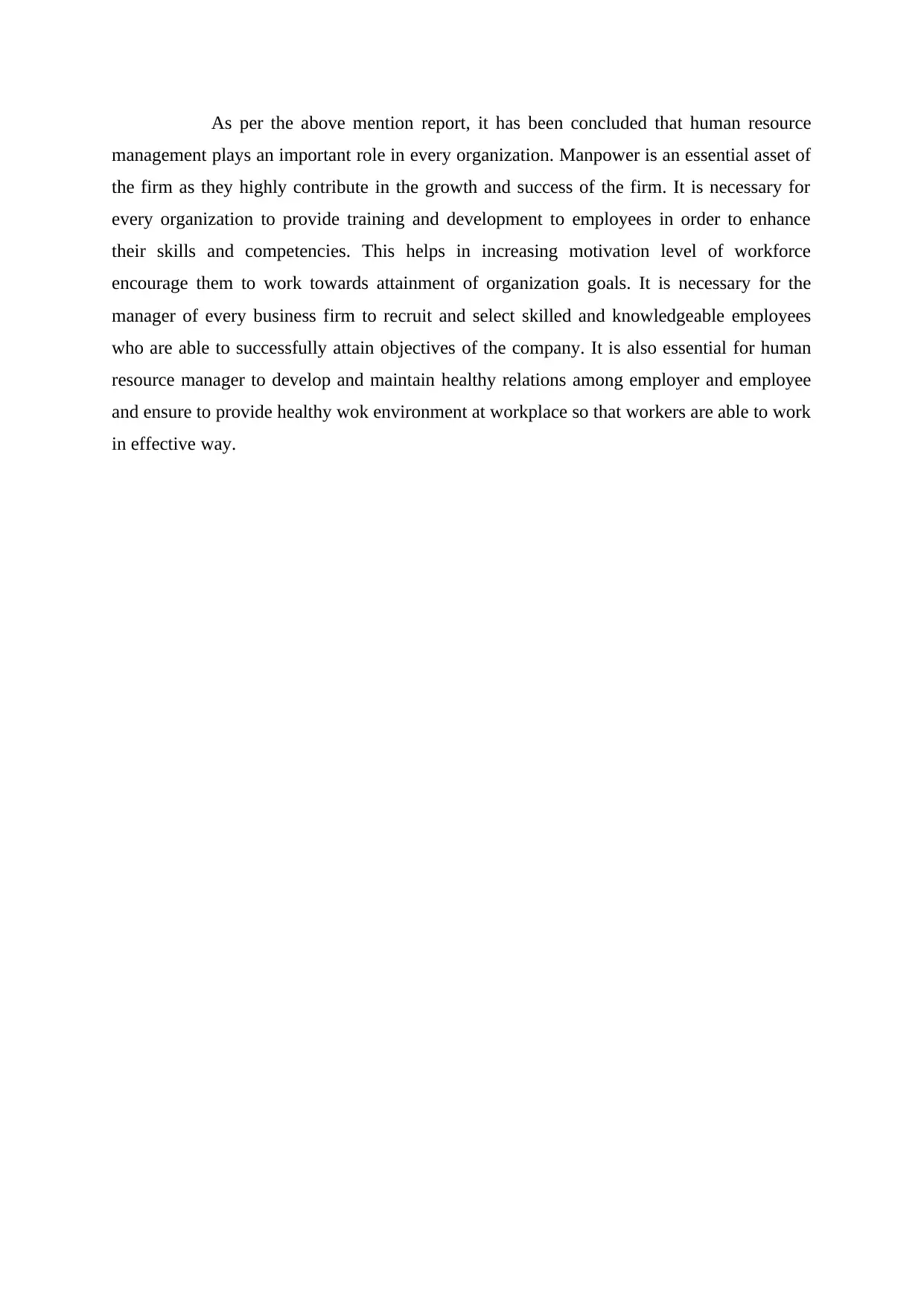
As per the above mention report, it has been concluded that human resource
management plays an important role in every organization. Manpower is an essential asset of
the firm as they highly contribute in the growth and success of the firm. It is necessary for
every organization to provide training and development to employees in order to enhance
their skills and competencies. This helps in increasing motivation level of workforce
encourage them to work towards attainment of organization goals. It is necessary for the
manager of every business firm to recruit and select skilled and knowledgeable employees
who are able to successfully attain objectives of the company. It is also essential for human
resource manager to develop and maintain healthy relations among employer and employee
and ensure to provide healthy wok environment at workplace so that workers are able to work
in effective way.
management plays an important role in every organization. Manpower is an essential asset of
the firm as they highly contribute in the growth and success of the firm. It is necessary for
every organization to provide training and development to employees in order to enhance
their skills and competencies. This helps in increasing motivation level of workforce
encourage them to work towards attainment of organization goals. It is necessary for the
manager of every business firm to recruit and select skilled and knowledgeable employees
who are able to successfully attain objectives of the company. It is also essential for human
resource manager to develop and maintain healthy relations among employer and employee
and ensure to provide healthy wok environment at workplace so that workers are able to work
in effective way.
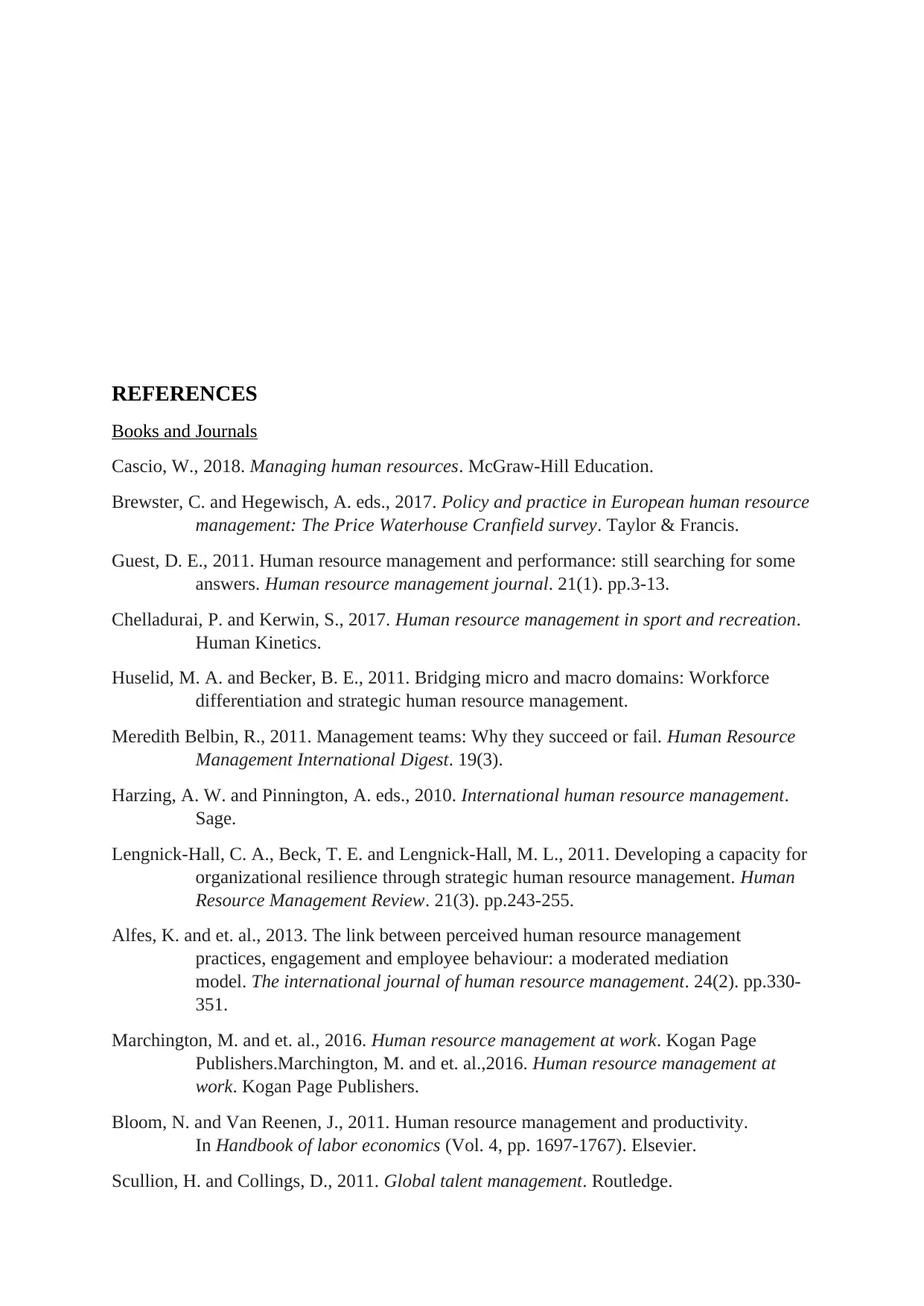
REFERENCES
Books and Journals
Cascio, W., 2018. Managing human resources. McGraw-Hill Education.
Brewster, C. and Hegewisch, A. eds., 2017. Policy and practice in European human resource
management: The Price Waterhouse Cranfield survey. Taylor & Francis.
Guest, D. E., 2011. Human resource management and performance: still searching for some
answers. Human resource management journal. 21(1). pp.3-13.
Chelladurai, P. and Kerwin, S., 2017. Human resource management in sport and recreation.
Human Kinetics.
Huselid, M. A. and Becker, B. E., 2011. Bridging micro and macro domains: Workforce
differentiation and strategic human resource management.
Meredith Belbin, R., 2011. Management teams: Why they succeed or fail. Human Resource
Management International Digest. 19(3).
Harzing, A. W. and Pinnington, A. eds., 2010. International human resource management.
Sage.
Lengnick-Hall, C. A., Beck, T. E. and Lengnick-Hall, M. L., 2011. Developing a capacity for
organizational resilience through strategic human resource management. Human
Resource Management Review. 21(3). pp.243-255.
Alfes, K. and et. al., 2013. The link between perceived human resource management
practices, engagement and employee behaviour: a moderated mediation
model. The international journal of human resource management. 24(2). pp.330-
351.
Marchington, M. and et. al., 2016. Human resource management at work. Kogan Page
Publishers.Marchington, M. and et. al.,2016. Human resource management at
work. Kogan Page Publishers.
Bloom, N. and Van Reenen, J., 2011. Human resource management and productivity.
In Handbook of labor economics (Vol. 4, pp. 1697-1767). Elsevier.
Scullion, H. and Collings, D., 2011. Global talent management. Routledge.
Books and Journals
Cascio, W., 2018. Managing human resources. McGraw-Hill Education.
Brewster, C. and Hegewisch, A. eds., 2017. Policy and practice in European human resource
management: The Price Waterhouse Cranfield survey. Taylor & Francis.
Guest, D. E., 2011. Human resource management and performance: still searching for some
answers. Human resource management journal. 21(1). pp.3-13.
Chelladurai, P. and Kerwin, S., 2017. Human resource management in sport and recreation.
Human Kinetics.
Huselid, M. A. and Becker, B. E., 2011. Bridging micro and macro domains: Workforce
differentiation and strategic human resource management.
Meredith Belbin, R., 2011. Management teams: Why they succeed or fail. Human Resource
Management International Digest. 19(3).
Harzing, A. W. and Pinnington, A. eds., 2010. International human resource management.
Sage.
Lengnick-Hall, C. A., Beck, T. E. and Lengnick-Hall, M. L., 2011. Developing a capacity for
organizational resilience through strategic human resource management. Human
Resource Management Review. 21(3). pp.243-255.
Alfes, K. and et. al., 2013. The link between perceived human resource management
practices, engagement and employee behaviour: a moderated mediation
model. The international journal of human resource management. 24(2). pp.330-
351.
Marchington, M. and et. al., 2016. Human resource management at work. Kogan Page
Publishers.Marchington, M. and et. al.,2016. Human resource management at
work. Kogan Page Publishers.
Bloom, N. and Van Reenen, J., 2011. Human resource management and productivity.
In Handbook of labor economics (Vol. 4, pp. 1697-1767). Elsevier.
Scullion, H. and Collings, D., 2011. Global talent management. Routledge.
⊘ This is a preview!⊘
Do you want full access?
Subscribe today to unlock all pages.

Trusted by 1+ million students worldwide
1 out of 15
Related Documents
Your All-in-One AI-Powered Toolkit for Academic Success.
+13062052269
info@desklib.com
Available 24*7 on WhatsApp / Email
![[object Object]](/_next/static/media/star-bottom.7253800d.svg)
Unlock your academic potential
Copyright © 2020–2025 A2Z Services. All Rights Reserved. Developed and managed by ZUCOL.





